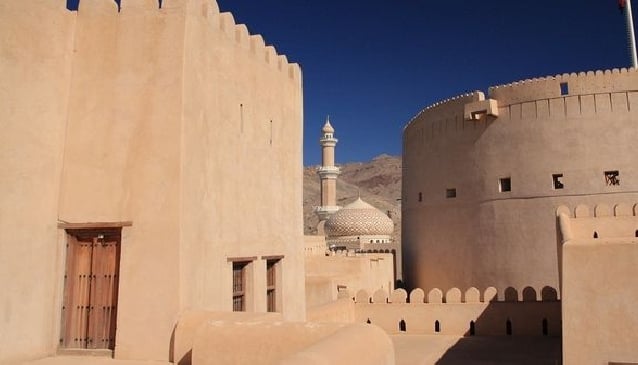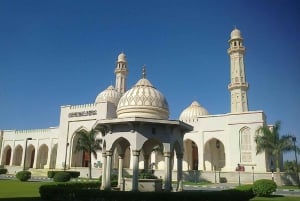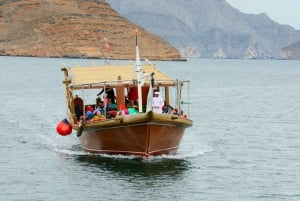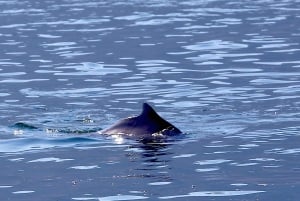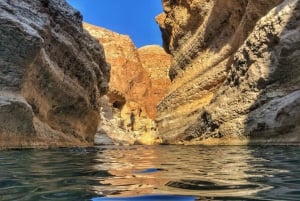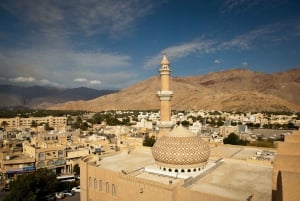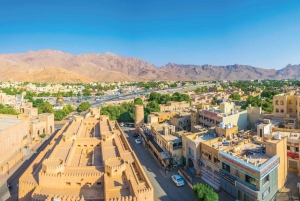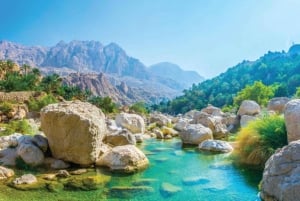Oman's Cultural Treasures
There are in excess of one hundred Omani-built forts and castles in Oman.
Book Top Experiences and Tours in Oman:
If youʻre booking your trip to Oman last minute, we have you covered. Below are some of the top tours and experiences!- Salalah: Private 4-Hour Sightseeing Tour
- Muscat: Big Bus Hop-On Hop-Off Sightseeing Tour
- Khasab: Khor Sham Half-Day Cruise with Snorkeling & Dolphins
- Muscat: Dolphin Watching and Snorkeling Tour
- From Khasab: Fjords of Musandam Dhow Cruise & Buffet Lunch
The land of is scattered with ancient forts and castles, protecting historic settlements along the coastline and throughout the interior areas. There are in excess of one hundred Omani-built forts and castles, each one with its own unique history, and each can be considered among the top attractions in Oman. Some are conveniently located within the capital city while others are just a short drive or picnic trip away.
Nizwa Fort is an excellent example to include in your travel itinerary, as it is located within the great city of Nizwa, famous for its fascinating souq. Nizwa is an Oasis town, which is filled by the Falaj Daris – a UNESCO World Heritage Site. The fort’s architecture is interesting for the number of sneaky traps, used to catch invaders unawares and send them plummeting to their death. Many of the old rooms have been transformed into themed displays, illustrating various aspects of castle life and an exhibits hall contains multimedia presentations and a wealth of artefacts to investigate.
Jabreen Castle is situated in the plain at the end of the Akhdar mountain range, which ultimately diminishes into the eerie Empty Quarter. The castle was built as a royal residence in 1670 AD and is decorated fittingly. Look up above you to discover splendid ceilings, hand painted with floral patterns akin to the designs used in Persian carpets. The atmospheric castle plays on natural light and shadows to create a continually moving interior design. The Imam Bil’arub built an unusual feature – a room for his horse next to his personal quarters. It was connected by a ramp down to the outside, enabling a speedy getaway if required. And it has also been said that he just wanted to be near his beloved horse!






The word Bahla translates as ‘blessings to God and good religious deeds’, which is intriguing as folklore says that the Bahla area was associated with troublesome djinns (genies) and spirits. Another UNESCO World Heritage Site, Bahla Fort Complex and the meandering mud brick wall, which used to protect the town, are remarkable in their antiquity and humble construction. Inside, old carved doors have been lovingly restored while an external section of the fort complex is undergoing a sensitive and lengthy restoration, using traditional and authentic methods. Visitors will be interested to view ancient burial chambers, visible via glass floor panels that have been laid in the mosque floor.
Four circular towers built in different eras defend the giant sprawling building that is Rustaq Fort. Entrance is gained through a series of guarded passageways, intersected with intricately carved, heavy wooden doors. Inside reveals a maze of rooms including a secret majlis for top-secret meetings and an underground escape passage. Geometric patterns on the interior are rendered with paint made using crushed local wadi pebbles.
Sohar Fort is unique as it is covered in a white lime wash instead of the natural sandy colour traditional of mud brick castles. The castle houses a museum within its citadel, detailing history of the area and displaying local crafts. The citadel is central to the five huge towers that circle the castle, within the boundary wall. It is said that at least one thousand men were required to defend the huge fort in times past.
The region of Dhofar is home to Mirbat Castle, which is positioned on the edge of the picturesque Mirbat bay. Military history places significance on The Battle of Mirbat as it was one of the last conflicts in the world to focus on the usual attack and defence of a fortress. The castle has a functional, military appearance with little in the way of external decoration. Inside however, is a different story as it is furnished lavishly in true Dhofari fashion of bright textiles and large tapestries. Weaponry is exhibited on the walls as well as displays of ceramics.




Khasab Castle sits on the peninsula of Musandam, the most northerly point of Oman. Separated by the Strait of Hormuz, it is not too far a distance from Iran. The castle has been beautifully refurbished in the period style it would have enjoyed, centuries before. Rooms have been set up to depict action scenes such as a schoolroom, wedding ceremony and craftspeople at work. One of the four towers has been converted into a library, where visitors can chill out and browse books on Omani history. The courtyard houses three traditionally built boats, used differently for fishing, pearling, ferrying cargo and trade.
A fascinating history is waiting to be discovered by the explorer who dares to dig deep and unearth the secrets of long ago, as brutal battles were fought and empires fiercely defended.


